Cercozoa
The Cercozoa are a group of single-celled eukaryotes. They lack shared morphological characteristics at the microscopic level,[5] being defined by molecular phylogenies of rRNA and actin or polyubiquitin.[6] They are the natural predators of many species of microbacteria and Archea.
| Cercozoa | |
|---|---|
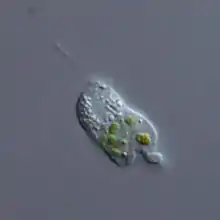 | |
| Cercomonas | |
| Scientific classification | |
| Domain: | Eukaryota |
| (unranked): | Diaphoretickes |
| Kingdom: | Chromista |
| Subkingdom: | Harosa |
| Infrakingdom: | Rhizaria |
| Phylum: | Cercozoa Cavalier-Smith 1998[1] |
| Groups[2] | |
| |
Characteristics
The group includes most amoeboids and flagellates that feed by means of filose pseudopods. These may be restricted to part of the cell surface, but there is never a true cytostome or mouth as found in many other protozoa. They show a variety of forms[2] and have proven difficult to define in terms of structural characteristics, although their unity is strongly supported by genetic studies. Cercozoa are closely related to Foraminifera and Radiolaria, amoeboids that usually have complex shells, and together with them form a supergroup called the Rhizaria.
Types
They are sometimes grouped by whether they are "filose" or "reticulose".[7]
Filose (subphylum Filosa)
The best-known Cercozoa are the euglyphids, filose amoebae with shells of siliceous scales or plates, which are commonly found in soils, nutrient-rich waters, and on aquatic plants. Some other filose amoebae produce organic shells, including the tectofilosids and Gromia. They were formerly classified with the euglyphids as the Testaceafilosia. This group is not monophyletic, but nearly all studied members fall in or near the Cercozoa, related to similarly shelled flagellates. Other notable filose cercozoans include the cercomonads, which are common soil flagellates.
Reticulose (subphylum Endomyxa)
Another important group placed here are the chlorarachniophytes, strange amoebae that form a reticulating net. They are set apart by the presence of chloroplasts, which apparently developed from an ingested green alga. They are bound by four membranes and still possess a vestigial nucleus, called a nucleomorph. As such, they have been of great interest to researchers studying the endosymbiotic origins of organelles.
Chlorarachniophytes are sometimes considered Filosa, rather than Endomyxa, while groups such as Gromia are considered Endomyxa.[8] Filosa is apparently a monophyletic group, but Endomyxa is paraphyletic.[9]
Ungrouped
In addition, three groups that are traditionally considered heliozoans belong here: the Heliomonadida, Desmothoracida, and Gymnosphaerida, which were recently grouped into the new class of Granofilosea.[7]
Finally, cercozoans include the Phaeodarea, marine protozoa that were previously considered radiolarians.
Classification
The exact composition and classification of the Cercozoa are still being worked out. A general scheme is:
| Class Chlorarachnea | Chlorarachniophyta |
| Class Proteomyxidea | Gymnophryida, Heliomonadida, Desmothoracida, Gymnosphaerida, etc. |
| Class Sarcomonadea | Cercomonadida |
| Class Imbricatea / Silicofilosea | Euglyphida and Thaumatomonadida |
| Class Thecofilosea | Tectofilosida and Cryomonadida |
| Class Phaeodarea | |
| Class Ebridea | Ebridea |
In addition two groups of parasites, the Phytomyxea and Ascetosporea, and the shelled amoeba Gromia may be basal Cercozoa, although some trees place them closer to the Foraminifera.
The spongomonads have been included here, but more recently have been considered Amoebozoa.
Some other small groups of protozoans are considered Cercozoa but are of uncertain placement, and it is likely many obscure genera will turn out to be cercozoans with further study.
Phylogeny
The initial molecular phylogenetic analyses of Cercozoa, based on ribosomal RNA and tubulins, recognized two subphyla, Endomyxa and Filosa, and showed a close relationship with phylum Retaria.[7][10]
However, the monophyly of the group was still uncertain. Posterior phylogenomic analyses consistently recovered Cercozoa as a paraphyletic group, and Endomyxa was often clustered with Retaria.[11][12][13] As a result, the current taxonomy of Rhizaria places Endomyxa inside the phylum Retaria instead of Cercozoa, which has therefore become synonymous with Filosa.[14]
| Rhizaria |
| ||||||||||||||||||||||||||||||
Despite the taxonomic change of Endomyxa into phylum Retaria, thanks to better phylogenomic sampling a 2019 analysis recovered phylum Cercozoa as a monophyletic group, with Endomyxa being the sister group to Filosa. In the same analysis, Endomyxa, Filosa, Reticulofilosa and Monadofilosa are proven to be monophyletic too.[15]
| Rhizaria |
| ||||||||||||||||||||||||||||||||||||
In addition to Endomyxa and Filosa, a variety of clades inside Cercozoa have been discovered in other analyses and have slowly been described and named, such as Tremulida (previously known as Novel Clade 11)[16] and Aquavolonida (Novel Clade 10),[17] although their specific positions among the two main cercozoan subphyla have yet to be refined.
Taxonomy
The taxonomy of Cercozoa as revised in 2018,[18] with Endomyxa shifted into Retaria:
- Phylum Cercozoa Cavaler-Smith, 1998 em. 2018
- Subphylum Reticulofilosa Cavaler-Smith, 1997
- Class Chlorarachnea Hibberd and Norris, 1984 (as Chlorarachniophyceae)
- Order Chlorarachnida Ishida et al., 1996 (as Chlorarachniales)
- Family Chlorarachniidae Ishida et al., 1996 (Bigelowiella, Chlorarachnion, Norisiella, Partenskyella, ?Cryptochlora)
- Family Gymnochloridae Cavalier-Smith, 2018 (Gymnochlora, Amorphochlora, Viridiuvalis)
- Family Lotharellidae Cavalier-Smith, 2018 (Lotharella)
- Order Minorisida Cavalier-Smith, 2018
- Family Minorisidae Cavalier-Smith, 2018 (Minorisa)
- Order Chlorarachnida Ishida et al., 1996 (as Chlorarachniales)
- Class Granofilosea Cavalier-Smith and Bass in Bass et al., 2009
- Order Cryptofilida Cavalier-Smith and Bass in Bass et al., 2009
- Family Nanofilidae Cavalier-Smith and Bass in Bass et al., 2009 (Nanofila)
- Family Mesofilidae Cavalier-Smith and Bass in Bass et al., 2009 (Mesofila)
- Order Desmothoracida Hertwig and Lesser, 1874
- Family Clathrulinidae Claus, 1874
- Order Leucodictyida Cavalier-Smith, 1993
- Family Leucodictyidae Cavalier-Smith, 1993
- Family Massisteriidae Cavalier-Smith, 1993
- Order Limnofilida Cavalier-Smith and Bass in Bass et al., 2009
- Family Limnofilidae Cavalier-Smith and Bass in Bass et al., 2009 (Limnofila)
- Order Axomonadida Cavalier-Smith in Yabuki et al., 2012
- Family Tetradimorphidae Febvre-Chevalier and Febvre, 1984 (Tetradimorpha)
- Order Cryptofilida Cavalier-Smith and Bass in Bass et al., 2009
- Class Skiomonadea Cavalier-Smith in Cavalier-Smith and Karpov, 2012
- Order Tremulida Cavalier-Smith and Hower in Howe et al., 2011
- Family Tremulidae Cavalier-Smith, 2018 (Tremula)
- Order Aquavolonida Bass et al., 2018 (Aquavolon)
- Order Tremulida Cavalier-Smith and Hower in Howe et al., 2011
- Class Chlorarachnea Hibberd and Norris, 1984 (as Chlorarachniophyceae)
- Subphylum Monadofilosa Cavalier-Smith, 1997
- Superclass Eoglissa Cavalier-Smith in Cavalier-Smith and Oates, 2011 em. 2018
- Class Metromonadea Cavalier-Smith, 2007
- Order Metopiida Cavalier-Smith in Cavalier-Smith and Chao, 2003
- Family Metopiidae Cavalier-Smith, 2003 (Metopion, Micrometopion)
- Order Metromonadida Bass and Cavalier-Smith, 2004
- Family Metromonadidae Bass and Cavalier-Smith, 2004 (Metromonas)
- Family Kiitoksiidae Cavalier-Smith in Cavalier-Smith and Scoble, 2014
- Order Metopiida Cavalier-Smith in Cavalier-Smith and Chao, 2003
- Class Helkesea Cavalier-Smith, 2018
- Order Helkesida Cavalier-Smith, 2018
- Superfamily Sainouroidea Cavalier-Smith in Cavalier-Smith et al., 2009 em. 2018
- Family Sainouridae Cavalier-Smith in Cavalier-Smith et al., 2008 (Sainouron, Cholamonas)
- Superfamily Helkesimastigoidea Cavalier-Smith 2018
- Family Helkesimastigidae Cavalier-Smith in Cavalier-Smith and Karpov, 2012 em. 2018 (Helkesimastix)
- Family Guttulinopsidae Olive, 1970 (Guttulinopsis, Rosculus)
- Superfamily Sainouroidea Cavalier-Smith in Cavalier-Smith et al., 2009 em. 2018
- Order Helkesida Cavalier-Smith, 2018
- Class Metromonadea Cavalier-Smith, 2007
- Superclass Ventrifilosa Cavalier-Smith in Cavalier-Smith and Karpov, 2012 em. 2018
- Class Sarcomonadea Cavalier-Smith, 1993 stat. nov. 1995 em. 2018
- Subclass Paracercomonada Cavalier-Smith 2018
- Order Paracercomonadida Cavalier-Smith 2018
- Family Paracercomonadidae Cavalier-Smith in Cavalier-Smith and Karpov, 2012 (Paracercomonas, Nucleocercomonas, Metabolomonas, Brevimastigomonas, Phytocercomonas)
- Order Paracercomonadida Cavalier-Smith 2018
- Subclass Pediglissa Cavalier-Smith 2018
- Order Cercomonadida Poche, 1913 em. Cavalier-Smith
- Family Cavernomonadidae Cavalier-Smith in Cavalier-Smith and Karpov, 2012 (Cavernomonas)
- Family Cercomonadidae Saville Kent, 1880/1 em. Cavalier-Smith
- Order Glissomonadida Howe et al., 2009
- Suborder Allapsina Cavalier-Smith 2018
- Family Allapsidae Howe et al., 2009 (Allapsa, Allantion, Teretomonas)
- Suborder Sandonina Cavalier-Smith 2018
- Family Bodomorphidae Hollande, 1952 (Bodomorpha)
- Family Sandonidae Howe et al., 2009 (Neoheteromita, Sandona, Flectomonas, Mollimonas)
- Family Proleptomonadidae Howe et al., 2009 (Proleptomonas)
- Suborder Pansomonadina Vickerman in Vickerman et al., 2005 stat. nov. 2018
- Family Viridiraptoridae Hess and Melkonian, 2013 (Viridiraptor, Orciraptor'')
- Family Agitatidae Cavalier-Smith and Bass in Bass et al., 2009 (Agitata)
- Family Acinetactidae Stokes, 1886 (Acinectatis)
- Family Aurigamonadidae Cavalier-Smith in Cavalier-Smith and Oates, 2011 (Aurigamonas)
- Suborder Allapsina Cavalier-Smith 2018
- Order Cercomonadida Poche, 1913 em. Cavalier-Smith
- Subclass Paracercomonada Cavalier-Smith 2018
- Class Imbricatea Cavalier-Smith in Cavalier-Smith and Chao, 2003 em. 2018
- Subclass Placonuda Cavalier-Smith in Cavalier-Smith and Chao, 2012
- Superorder Nudisarca Cavalier-Smith in Cavalier-Smith and Chao, 2012
- Order Variglissida Cavalier-Smith in Scoble and Cavalier-Smith, 2014
- Family Clautriaviidae Cavalier-Smith in Cavalier-Smith and Scoble, 2013 (Clautriavia)
- Family Nudifilidae Cavalier-Smith and Howe in Howe et al., 2011 (Nudifila)
- Family Quadriciliidae Cavalier-Smith, 2018 (Quadricilia)
- Order Marimonadida Cavalier-Smith and Bass in Howe et al., 2011
- Family Auranticordidae Cavalier-Smith, 2018 (Auranticordis, Rhabdamoeba)
- Family Cyranomonadidae Cavalier-Smith, 2018 (Cyranomonas)
- Family Pseudopirsoniidae Cavalier-Smith, 2018 (Pseudopirsonia)
- Family Abolliferidae Cavalier-Smith, 2018 (Abollifer, Cowlomonas, ?Heterochromonas)
- Order Variglissida Cavalier-Smith in Scoble and Cavalier-Smith, 2014
- Superorder Euglyphia Cavalier-Smith, 2018
- Order Euglyphida Copeland, 1956 em. Cavalier-Smith, 1987
- Family Euglyphidae Wallich, 1864 (Euglypha)
- Family Trinematidae Hoogenraad and De Groot, 1940 (Corythion, Trinema)
- Family Sphenoderiidae Chatelain et al., 2013 (Sphenoderia, Trachelocorythion)
- Family Assulinidae Lara et al., 2006 (Assulina, Placocista)
- Family Cyphoderiidae De Saedeleer, 1934 (Cyphoderia, Corothionella, Pseudocorythion)
- Family Paulinellidae De Saedeleer, 1934 (Paulinella, Ovulinata, Micropyxidiella)
- Order Zoelucasida Cavalier-Smith in Scoble and Cavalier-Smith, 2014
- Family Zoelucasidae Cavalier-Smith in Scoble and Cavalier-Smith, 2014 (Zoelucasa)
- Order Euglyphida Copeland, 1956 em. Cavalier-Smith, 1987
- Superorder Discomonada Cavalier-Smith 2018
- Order Discomonadida Cavalier-Smith in Scoble and Cavalier-Smith, 2014
- Family Discomonadidae Cavalier-Smith in Scoble and Cavalier-Smith, 2014 (Discomonas)
- Order Discomonadida Cavalier-Smith in Scoble and Cavalier-Smith, 2014
- Superorder Nudisarca Cavalier-Smith in Cavalier-Smith and Chao, 2012
- Subclass Placoperta Cavalier-Smith in Cavalier-Smith and Chao, 2012
- Superorder Placofila Cavalier-Smith in Cavalier-Smith and Chao, 2012
- Order Thaumatomonadida Shirkina, 1987
- Family Thaumatomonadidae Hollande, 1952 (Allas, Ovaloplaca, Reckertia, Scutellomonas, Thaumatomonas, Thaumatospina, Penardeugenia)
- Family Peregriniidae Cavalier-Smith in Howe et al., 2011 (Peregrinia, Gyromitus)
- Family Esquamulidae Shiratori et al., 2012 (Esquamula)
- Order Discocelida Cavalier-Smith, 1997
- Family Discoceliidae Cavalier-Smith, 1993 orthog. em. 2012 (Discocelia)
- Order Thaumatomonadida Shirkina, 1987
- Superorder Perlatia Cavalier-Smith in Cavalier-Smith and Chao, 2012
- Order Spongomonadida Hibberd, 1983
- Family Spongomonadidae Karpov, 1990 (Spongomonas, Rhipidodendron)
- Order Perlofilida Cavalier-Smith in Cavalier-Smith and Chao, 2012
- Family Pompholyxophryidae Page, 1987 (Pompholyxophrys)
- Family Acanthoperlidae Cavalier-Smith in Cavalier-Smith and Chao, 2012 (Acanthoperla)
- Order Spongomonadida Hibberd, 1983
- Superorder Placofila Cavalier-Smith in Cavalier-Smith and Chao, 2012
- Subclass Krakenia Cavalier-Smith, 2018
- Order Krakenida Dumack et al., 2017 ex Cavalier-Smith 2018
- Family Krakenidae Dumack et al., 2017 (Kraken)
- Order Krakenida Dumack et al., 2017 ex Cavalier-Smith 2018
- Subclass Placonuda Cavalier-Smith in Cavalier-Smith and Chao, 2012
- Class Thecofilosea Cavalier-Smith in Cavalier-Smith and Chao, 2003 em. 2012
- Subclass Ventricleftia Cavalier-Smith, 2018
- Order Ventricleftida Cavalier-Smith in Howe et al., 2011
- Family Ventrifissuridae Cavalier-Smith, 2018 (Ventrifissura)
- Family Verrucomonadidae Cavalier-Smith, 2018 (Verrucomonas)
- Order Ventricleftida Cavalier-Smith in Howe et al., 2011
- Subclass Eothecia Cavalier-Smith in Cavalier-Smith and Chao, 2012
- Order Matazida Cavalier-Smith in Cavalier-Smith and Chao, 2012
- Family Matazidae Cavalier-Smith in Cavalier-Smith and Chao, 2012
- Order Ebriida Deflandre, 1936 (Ebria, Hermesinum, Botuliforma)
- Order Cryomonadida Cavalier-Smith, 1993
- Family Cryomonadidae Cavalier-Smith, 1993 (Cryothecomonas)
- Family Protaspidae Cavalier-Smith, 1993 (Protaspa)
- Family Rhogostomidae Dumack et al., 2017 (Rhogostoma, Capsellina, Sacciforma)
- Order Matazida Cavalier-Smith in Cavalier-Smith and Chao, 2012
- Subclass Phaeodaria Haeckel, 1879
- Order Eodarida Cavalier-Smith in Cavalier-Smith and Chao, 2012
- Order Opaloconchida Cavalier-Smith in Cavalier-Smith and Chao, 2012
- Subclass Tectosia Cavalier-Smith in Cavalier-Smith and Chao, 2012
- Order Tectofilosida Cavalier-Smith in Cavalier-Smith and Chao, 2003
- Family Chlamydophryidae De Saedeleer, 1934
- Family Psammonobiotidae Golemansky, 1974
- Family Volutellidae Sudzuki, 1979 (Volutella)
- Suborder Fiscullina Cavalier-Smith, 2018
- Family Fiscullidae Dumack, Mausback and Bonkowski in Dumack et al., 2017 (Fisculla)
- Family Pseudodifflugiidae De Saedeleer, 1934
- Family Rhizaspididae Skuja, 1948 (Rhizaspis)
- Order Tectofilosida Cavalier-Smith in Cavalier-Smith and Chao, 2003
- Subclass Ventricleftia Cavalier-Smith, 2018
- Class Sarcomonadea Cavalier-Smith, 1993 stat. nov. 1995 em. 2018
- Superclass Eoglissa Cavalier-Smith in Cavalier-Smith and Oates, 2011 em. 2018
- Subphylum Reticulofilosa Cavaler-Smith, 1997
 Cercomonas sp. (Cercozoa: Cercomonadida)
Cercomonas sp. (Cercozoa: Cercomonadida) Ebria sp. (Cercozoa: Ebridea)
Ebria sp. (Cercozoa: Ebridea)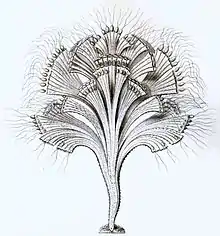 Rhipidodendron sp. (Cercozoa: Spongomonadea)
Rhipidodendron sp. (Cercozoa: Spongomonadea)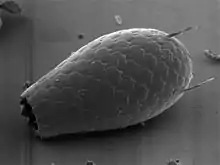 Euglypha sp. (Cercozoa: Euglyphida)
Euglypha sp. (Cercozoa: Euglyphida)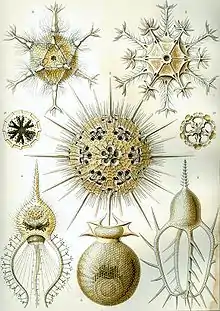 Phaeodarians (Cercozoa: Phaeodarea)
Phaeodarians (Cercozoa: Phaeodarea) Clathrulina elegans (Cercozoa: Granofilosea: Desmothoracida)
Clathrulina elegans (Cercozoa: Granofilosea: Desmothoracida)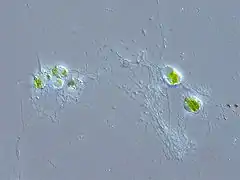 Chlorarachnion sp. (Cercozoa: (Chlorarachniophyta)
Chlorarachnion sp. (Cercozoa: (Chlorarachniophyta)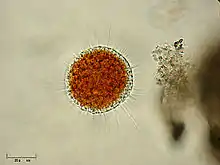 Vampyrella sp. (Cercozoa: Vampyrellidae)
Vampyrella sp. (Cercozoa: Vampyrellidae) Orciraptor agilis (Viridiraptoridae) attacking Mougeotia sp. (Zygnemataceae)
Orciraptor agilis (Viridiraptoridae) attacking Mougeotia sp. (Zygnemataceae)_b_083.jpg.webp)
_of_potatoes_(1914)_(14577838889).jpg.webp) Powdery scab (Cercozoa: Plasmodiophorida)
Powdery scab (Cercozoa: Plasmodiophorida)
References
- Cavalier-Smith, T. (1998). "A revised six-kingdom system of life". Biological Reviews of the Cambridge Philosophical Society. 73 (3): 203–266. doi:10.1111/j.1469-185X.1998.tb00030.x. PMID 9809012. S2CID 6557779.
- Cavalier-Smith T, Chao EE (October 2003). "Phylogeny and classification of phylum Cercozoa (Protozoa)" (PDF). Protist. 154 (3–4): 341–58. doi:10.1078/143446103322454112. PMID 14658494.
- Nikolaev SI, Berney C, Fahrni JF, et al. (May 2004). "The twilight of Heliozoa and rise of Rhizaria, an emerging supergroup of amoeboid eukaryotes". Proc. Natl. Acad. Sci. U.S.A. 101 (21): 8066–71. doi:10.1073/pnas.0308602101. PMC 419558. PMID 15148395.
- Hoppenrath, M.; Leander B.S. (2006). "Ebriid phylogeny and the expansion of the Cercozoa". Protist. 157 (3): 279–90. doi:10.1016/j.protis.2006.03.002. PMID 16730229.
- Chantangsi, C. (2009). Comparative morphology and molecular evolution of marine interstitial cercozoans. PhD thesis. University of British Columbia.
- "SYSTEMATIC BIOLOGY: CERCOZOA". Retrieved 2009-03-28.
- Bass D, Chao EE, Nikolaev S, et al. (February 2009). "Phylogeny of Novel Naked Filose and Reticulose Cercozoa: Granofilosea cl. n. and Proteomyxidea Revised". Protist. 160 (1): 75–109. doi:10.1016/j.protis.2008.07.002. PMID 18952499.
- "Cercozoa". Retrieved 2009-05-21.
- Nakamura, Yasuhide; Imai, Ichiro; Yamaguchi, Atsushi; Tuji, Akihiro; Not, Fabrice; Suzuki, Noritoshi (2015). "Molecular Phylogeny of the Widely Distributed Marine Protists, Phaeodaria (Rhizaria, Cercozoa)". Protist. 166 (3): 363–373. doi:10.1016/j.protis.2015.05.004. PMID 26083083.
- Howe; et al. (2011), "Novel Cultured Protists Identify Deep-branching Environmental DNA Clades of Cercozoa: New Genera Tremula, Micrometopion, Minimassisteria, Nudifila, Peregrinia", Protist, 162 (2): 332–372, doi:10.1016/j.protis.2010.10.002, PMID 21295519
- Burki F, Corradi N, Sierra R, Meyer GR, Abbott CL, Keeling PJ, et al. (July 2013). "Phylogenomics of the Intracellular Parasite Mikrocytos mackini Reveals Evidence for a Mitosome in Rhizaria". Current Biology. 23 (16): 1541–1547. doi:10.1016/j.cub.2013.06.033. PMID 23891116. S2CID 8257631.
- Burki F, Kudryavtsev A, Matz MV, et al. (2010). "Evolution of Rhizaria: new insights from phylogenomic analysis of uncultivated protists". BMC Evol Biol. 10: 377. doi:10.1186/1471-2148-10-377. PMC 3014934. PMID 21126361.
- Krabberød, Anders K.; Orr, Russell J.S.; Bråte, Jon; Kristensen, Tom; Bjørklund, Kjell R.; Shalchian-Tabrizi, Kamran (2017). "Single Cell Transcriptomics, Mega-Phylogeny, and the Genetic Basis of Morphological Innovations in Rhizaria". Mol. Biol. Evol. 34 (7): 1557–1573. doi:10.1093/molbev/msx075. PMC 5455982. PMID 28333264.
- Cavalier-Smith, Thomas; E. Chao, Ema; Lewis, Rhodri (2018), "Multigene phylogeny and cell evolution of chromist infrakingdom Rhizaria: contrasting cell organisation of sister phyla Cercozoa and Retaria", Protoplasma, 255 (5): 1517–1574, doi:10.1007/s00709-018-1241-1, PMC 6133090, PMID 29666938
- Irwin, Nicholas A.T.; Tikhonenkov, Denis V.; Hehenberger, Elisabeth; Mylnikov, Alexander P.; Burki, Fabien; Keeling, Patrick J. (2019-01-01). "Phylogenomics supports the monophyly of the Cercozoa". Molecular Phylogenetics and Evolution. 130: 416–423. doi:10.1016/j.ympev.2018.09.004. ISSN 1055-7903. PMID 30318266. S2CID 52982396.
- Howe, Alexis T.; Bass, David; Scoble, Josephine M.; Lewis, Rhodri; Vickerman, Keith; Arndt, Hartmut; Cavalier-Smith, Thomas (2011). "Novel Cultured Protists Identify Deep-branching Environmental DNA Clades of Cercozoa: New Genera Tremula, Micrometopion, Minimassisteria, Nudifila, Peregrinia". Protist. 162 (2): 332–372. doi:10.1016/j.protis.2010.10.002. ISSN 1434-4610. PMID 21295519.
- Bass D, Tikhonenkov DV, Foster R, Dyal P, Janouškovec J, Keeling PJ, Gardner M, Neuhauser S, Hartikainen H, Mylnikov AP, Berney C (2018). "Rhizarian 'Novel Clade 10' Revealed as Abundant and Diverse Planktonic and Terrestrial Flagellates, including Aquavolon n. gen". Journal of Eukaryotic Microbiology. 65 (6): 828–842. doi:10.1111/jeu.12524. PMC 6282753. PMID 29658156.
- Cavalier-Smith, Thomas; Chao, Ema E.; Lewis, Rhodri (April 2018). "Multigene phylogeny and cell evolution of chromist infrakingdom Rhizaria: contrasting cell organisation of sister phyla Cercozoa and Retaria". Protoplasma. 255 (5): 1517–1574. doi:10.1007/s00709-018-1241-1. PMC 6133090. PMID 29666938.
External links
- Tree of Life Cercozoa
- phylogeny of Phaeodarea